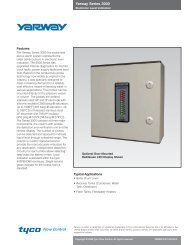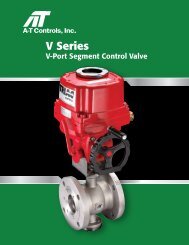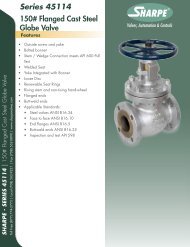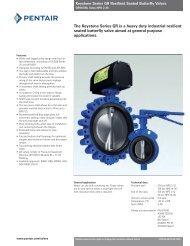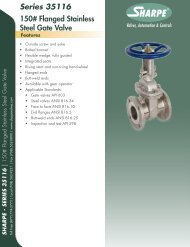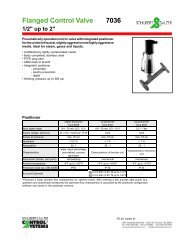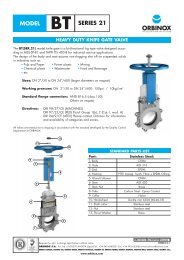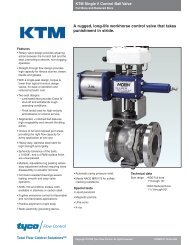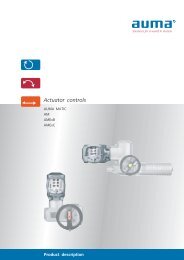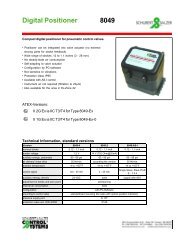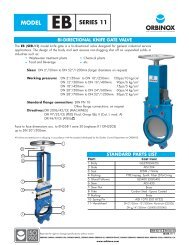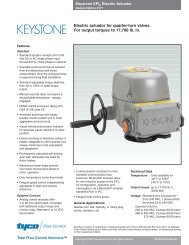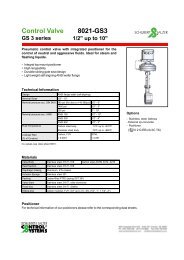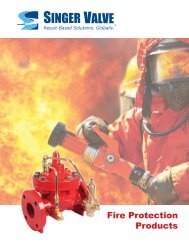Tideflex Mixing System Catalog - RM Headlee
Tideflex Mixing System Catalog - RM Headlee
Tideflex Mixing System Catalog - RM Headlee
Create successful ePaper yourself
Turn your PDF publications into a flip-book with our unique Google optimized e-Paper software.
OPERATION OF TMS RECTANGULAR RESERVOIRS<br />
The <strong>Tideflex</strong> ® <strong>Mixing</strong> <strong>System</strong> was designed<br />
to be simple, reliable and cost effective.<br />
The system makes use of the patented<br />
<strong>Tideflex</strong> ® Check Valve and a simple piping<br />
manifold. This reduces cost by minimizing<br />
the amount of pipe and fittings required for<br />
a separate inlet and outlet. By discharging<br />
water from one side of the reservoir and<br />
draining from the other, the system ensures<br />
that the water supply is constantly “turned<br />
over” to avoid stagnation and dead zones.<br />
The mixing system works in two phases.<br />
When the reservoir is being filled<br />
(Figure 2a), the pressure of the water in<br />
the manifold forces the TF-2 or Series 35<br />
“discharge” valves to open, and holds the<br />
Series 37 “drain” valves closed on the<br />
opposite side. When the reservoir is<br />
drained (Figure 2b), the head pressure<br />
above the manifold holds the discharge<br />
valves closed and forces the drain valves<br />
to open. This two-stage system ensures<br />
that the water is continually cycled.<br />
Figure 2<br />
,,<br />
,,,<br />
,<br />
,,<br />
,,<br />
,,<br />
,,<br />
(a) Filling Sequence<br />
The simplicity of the system makes it<br />
reliable, with no moving parts, electric<br />
motors, bearings or seals to maintain.<br />
There is no additional energy consumption<br />
and no equipment exposed to the<br />
elements. The system can be fitted as part<br />
of a new construction or easily retrofitted<br />
to an existing reservoir.<br />
12" TF-2 discharging.<br />
(b) Draining Sequence<br />
OPERATION OF TMS CIRCULAR RESERVOIRS<br />
In circular reservoirs, a manifold pipe is<br />
extended across the reservoir to the far<br />
side. On the far side, TF-2 or Series 35<br />
Check Valves are installed that open during<br />
filling of the reservoir and are closed during<br />
draining of the tank (Figure 3a).<br />
<strong>Tideflex</strong> ® Check Valve is a variable orifice<br />
which discharges a high-momentum jet<br />
compared to open-ended pipes. Also,<br />
<strong>Tideflex</strong> ® valves discharge an elliptically<br />
shaped jet, not circular. The elliptical jet<br />
creates a strong sheer plane which also<br />
improves the mixing.<br />
Since the reservoir is circular, the highmomentum<br />
jets discharged from the<br />
<strong>Tideflex</strong> ® create turbulence that is carried<br />
around the circumference and across the<br />
entire cross section of the tank.<br />
Draining is accomplished from the near<br />
side of the reservoir where the pipe enters.<br />
On this side, a “tee” is installed whereby<br />
multiple Series 37 <strong>Tideflex</strong> ® valves are<br />
installed. These valves are closed during<br />
filling of the tank and open during draining<br />
of the tank (Figure 3b).<br />
Figure 3<br />
,,, ,,,<br />
,,, ,,,<br />
,,, ,,,<br />
,,, ,,,<br />
,,, ,,,<br />
(a) Filling Sequence<br />
Figures shown are general representations.<br />
Custom designs are required for<br />
individual reservoirs based on tank<br />
design and operating conditions.<br />
(2) 16" Series 37 as drain valves.<br />
(b) Draining Sequence



